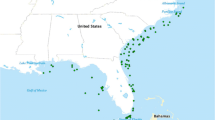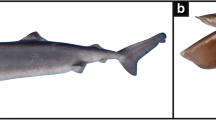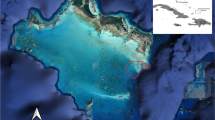Abstract
Tiger sharks, Galeocerdo cuvier, are apex predators in a variety of nearshore ecosystems throughout the world. This study investigates the biology of tiger sharks in the shallow seagrass ecosystem of Shark Bay, Western Australia. Tiger sharks (n = 252) were the most commonly caught species (94%) compared to other large sharks. Tiger sharks ranged from 148–407 cm TL. The overall sex ratio was biased towards females (1.8 : 1), but the sex ratio of mature animals (> 300 cm TL) did not differ from 1 : 1. Contrary to previous accounts, tiger sharks were caught more often in all habitats during daylight hours than at night. Tiger shark catch rates were highly correlated with water temperature and were highest when water temperatures were above 19°C. The seasonal abundance of tiger sharks is correlated to both water temperature and the occurrence of their main prey: sea snakes and dugongs, Dugong dugon. Stomach contents analysis indicated that sea turtles and smaller elasmobranchs were also common prey. The importance of major seagrass grazers (dugongs and green sea turtles, Chelonia mydas) in the diet of tiger sharks suggests the possibility that these sharks are keystone predators in this ecosystem.
Similar content being viewed by others
References
Anderson, P.K. 1982. Studies of dugongs at Shark Bay, Western Australia. I. Analysis ofpopulation size, composition, dispersion, and habitat use on the basis of aerial survey. Aust. Wildl. Res. 9: 69–84.
Bigelow, H.B. & W.C. Schroeder. 1948. Fishes of the western North Atlantic. I. Sharks. MemoirSears Foundation Marine Research 1: 59–576.
Compagno, L.J.V. 1984. FAO species catalogue, volume4. Sharks of the world. Part 2 - Carcharhiniformes. FAO Fisheries Synopsis 125: 1–655.
Cresswell, G.R.1991. The Leeuwin Current - observations and recent models. J. Roy. Soc. Western Australia 74: 1–14.
de Iongh, H.H., B.J. Wenno & E. Meelis. 1995. Seagrass distribution and seasonal biomass change inrelation to dugong grazing in the Moluccas, east Indonesia. Aquat. Bot. 50: 1–19.
Holland, K.N.,B.W. Wetherbee, C.G. Lowe & C.G. Meyer. 1999. Movements of tiger sharks (Galeocerdo cuvier) in coastal Hawaiian waters. Mar. Biol. 134: 665–673.
Kohler, N.E., J.G. Casey & P.A. Turner. 1998.NMFSCooperative tagging program, 1962-93: an atlas of shark tag and recapture data. Mar. Fish. Rev. 60: 1–87.
Lanyon, J.M., C.J. Limpus & H. Marsh. 1989. Dugongs and turtles: grazers in the seagrass system. pp.610-634. In: A.W.D. Larkum, A.J. McComb & S.A. Shepherd (ed.) Biology of Seagrasses, Elsevier, New York.
Lowe, C.G., B.M. Wetherbee, G.L. Crow & A.L. Tester. 1996. Ontogenetic dietary shifts andfeeding behavior of the tiger shark, Galeocerdo cuvier, in Hawaiian waters. Env. Biol. Fish. 47: 203–211.
Paine, R.T. 1966. Food web complexity and species diversity. Amer. Nat. 100: 65–75.
Preen, A.1995. Impacts of dugong foraging on seagrass habitats: observational and experimental evidence for cultivation grazing. Mar. Ecol. Prog. Ser. 124: 201–213.
Preen, A.R., H. Marsh, I.R. Lawler, R.I.T. Prince & R. Shepherd. 1997. Distribution and abundance of dugongs, turtles, dolphins and other megafauna in Shark Bay, Ningaloo Reef, and Exmouth Gulf, Western Australia. Wildl. Res. 24: 185–208.
Rancurel, P. & A. Intes. 1982. Le requin tigre, Galeocerdo cuvieri Lacépède, des eaux Néocalédoniennes examen des contenus stomacaux. Tethys 10: 195–199.
Randall, J.E. 1992. Review of the biology ofthe tiger shark (Galeocerdo cuvier). Aust. J. Mar. Freshwat. Res. 43: 21–31.
Simpfendorfer, C. 1992.Biology of tiger sharks (Galeocerdo cuvier) caught by the Queensland shark meshing program off Townsville, Australia. Aust. J. Mar. Freshwat. Res. 43: 33–43.
Simpfendorfer, C.A., A.B. Goodreid & R.B. McAuley.2001. Size, sex, and geographic variation in the diet of the tiger shark, Galeocerdo cuvier, fromWestern Australian waters. Env. Biol. Fish. (in press).
Stevens, J.D. 1984. Biological observations on sharks caught bysportfishermen off New South Wales. Aust. J. Mar. Freshwat. Res. 42: 151–199.
Walker, D.I. 1989.Regional studies - seagrass in Shark Bay, the foundation of an ecosystem. pp. 182–210. In: A.W.D. Larkum, A.J. McComb & S.A. Shepherd (ed.) Biology of Seagrasses, Elsevier, New York.
Author information
Authors and Affiliations
Rights and permissions
About this article
Cite this article
Heithaus, M.R. The Biology of Tiger Sharks, Galeocerdo Cuvier, in Shark Bay, Western Australia: Sex Ratio, Size Distribution, Diet, and Seasonal Changes in Catch Rates. Environmental Biology of Fishes 61, 25–36 (2001). https://doi.org/10.1023/A:1011021210685
Issue Date:
DOI: https://doi.org/10.1023/A:1011021210685




